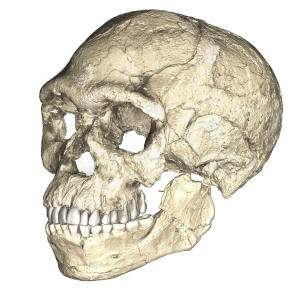Genome data sheds light on how Homo sapiens arose in Africa
 Send a link to a friend
Send a link to a friend
 [May 19, 2023]
By Will Dunham [May 19, 2023]
By Will Dunham
WASHINGTON (Reuters) - Our species arose in Africa more than 300,000
years ago, with the oldest-known Homo sapiens fossils discovered at a
site in Morocco called Jebel Irhoud, located between Marrakech and the
Atlantic coast.
But the scarcity of Homo sapiens fossils from early in our evolutionary
history and the geographical spread of those remains in Africa in places
like Ethiopia and South Africa have made it difficult to piece together
how our species emerged and dispersed across the continent before
trekking worldwide. A new study tapping into genome data from modern-day
African populations is offering insight into how this may have unfolded.
The research indicated that multiple ancestral groups from across Africa
contributed to the emergence of Homo sapiens in a patchwork manner,
migrating from one region to another and mixing with one another over
hundreds of thousands of years. It also found that everyone alive today
can trace their ancestry to at least two distinct populations that were
present in Africa dating back about a million years.
The findings did not support a longstanding hypothesis that a single
region in Africa gave rise to Homo sapiens or a scenario involving
mixture with an unidentified closely related species in the human
evolutionary lineage within Africa.

"All humans share relatively recent common ancestry, but the story in
the deeper past is more complicated than our species evolving in just a
single location or in isolation," said University of Wisconsin-Madison
population geneticist Aaron Ragsdale, lead author of the study published
this week in the journal Nature.
The ancestral groups were likely spread across a geographic landscape in
a population structure that, Ragsdale said, "was 'weak,' meaning that
there was ongoing or at least recurrent migration between groups, and
this maintained genetic similarity across ancestral populations."
Because of the paucity of fossil remains and archaeological evidence,
the researchers turned to genome data from living people to find clues
about the past. They examined genome data from 290 people, mostly from
four geographically and genetically diverse African peoples, to trace
the similarities and differences between the populations and identify
genetic interconnections over hundreds of thousands of years.
[to top of second column]
|

A composite reconstruction of the
earliest known Homo sapiens fossils from Jebel Irhoud in Morocco,
based on micro computed tomographic scans of multiple original
fossils, is shown in this undated handout photo obtained by Reuters
June 7, 2017. Philipp Gunz, MPI EVA Leipzig/Handout via REUTERS/File
Photo

These included: 85 individuals from a West African group called the
Mende from Sierra Leone; 44 individuals from the Nama Khoe-San group
from southern Africa; 46 individuals from the Amhara and Oromo
groups in Ethiopia; and 23 individuals from the Gumuz group, also
from Ethiopia. Genome data also was examined from 91 Europeans to
account for post-colonial era influence and from a Neanderthal, the
extinct human species that was concentrated in Europe until about
40,000 years ago.
The fossil record is scanty in the time period that would be most
informative about the emergence and spread of Homo sapiens, and
there is no ancient DNA from skeletal or dental remains from these
time periods, the researchers said.
"While we find evidence of anatomically modern human remains and
artifacts in different parts of Africa, they are so sparse in space
and time that it is difficult to understand their relationships with
each other, and with us," said study geneticist and study co-author
Simon Gravel of McGill University in Montreal. "Were they related to
each other? Are they related to our ancestors, or were they local
populations who went extinct?"
"Genetic data was inherited from a continuous chain of transmissions
dating back to well before the origins of modern humans. The
relatedness among contemporary humans contains a lot of information
about this chain of events," Gravel added. "By building models of
how these transmissions occurred, we can test detailed models that
relate past populations to present-day populations."
(Reporting by Will Dunham, Editing by Rosalba O'Brien)
[© 2023 Thomson Reuters. All rights
reserved.]This material may not be published,
broadcast, rewritten or redistributed.
Thompson Reuters is solely responsible for this content.
 |